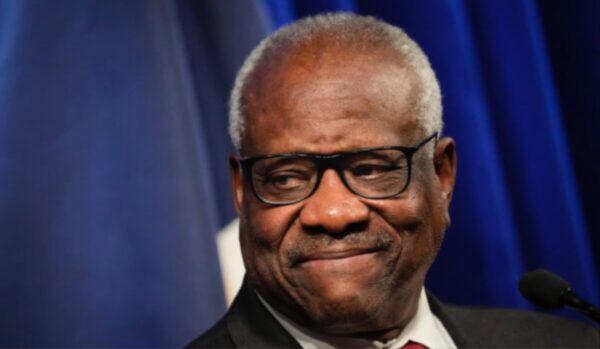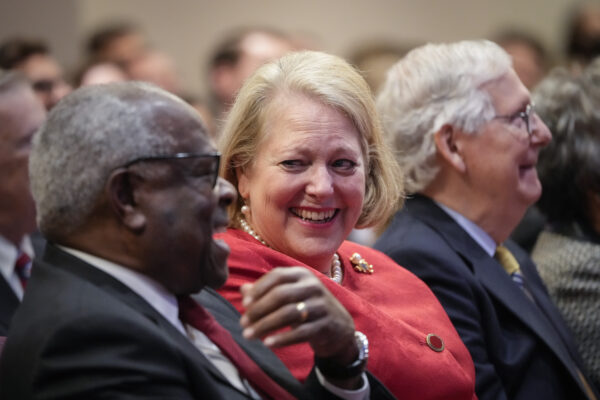Supreme Court Justice Clarence Thomas was hundreds of thousands of dollars in debt more than two decades ago when he pressured a Republican congressman to propose a pay raise for justices just a month after he purchased a luxury RV with a $267,000 loan he was not required to pay back.
Associates said Thomas had major financial problems in early 2000, even after he was seated on the nation’s highest court for nearly a decade, according to the latest documents to emerge in the scandal that involved luxury travel and gifts extended to Thomas over the past 20 or more years.
The newest revelation in the case follows the explosive report by ProPublica last spring that revealed Justice Thomas had taken gifts from a number of billionaire Republican megadonors, including former Berkshire Hathaway executive David Sokol, former Miami Dolphins owner H. Wayne Huizenga, and Dallas real estate tycoon Harlan Crow, among others.

The Senate Finance Committee is currently investigating Thomas’ financial dealings over the past two decades amid increased calls for tougher ethics rules and for Thomas to resign.
Separately, in June, Supreme Court Justice Samuel Alito also sought to dispel a ProPublica report alleging he went on a luxury Alaskan fishing excursion 15 years ago with a billionaire Republican donor whose hedge fund was the subject of several high court rulings in which Alito never recused himself.
Back in January 2000, Thomas and his wife, Ginni, were reportedly struggling to afford additional expenses as they began raising his grandnephew, but Thomas was still able to stay at a lavish beach resort in Sea Island, Georgia, where he gave a keynote speech at a conservative conference, according to the latest findings by ProPublica.
When Thomas made the trip to Georgia, his accommodations were paid for by the Heritage Foundation, a Washington-based conservative policy institute that was sponsoring the convention, known then as the “Awakening.”
In previous financial disclosure statements, Thomas reported taking nearly a dozen trips at no cost throughout 2000 to destinations like colleges and universities. Still, inexplicably, he never reported his travels to the conservative conference in Georgia, which may have been a violation of federal disclosure rules.
By chance, Thomas wound up sitting next to Florida Rep. Cliff Stearns on the flight back to Washington, giving Thomas the perfect opportunity to complain about needing a raise while also warning that “one or more justices” might resign soon if the House failed to deliver on a new pay deal.
Later, Stearns wrote to Thomas, pledging to explore legislation aimed at giving Supreme Court justices more money.
“As we agreed, it is worth a lot to Americans to have the Constitution properly interpreted. We must have the proper incentives here, too.” Stearns said to Thomas — unaware that a month earlier, Thomas had accepted the quarter-million dollar loan to buy the motorhome but never reported the transaction on his taxes or annual financial disclosure statements, The New York Times reported last August.
Thomas paid the interest but not a cent toward the principal, according to the Senate Finance Committee, which claims Anthony Welters, a prominent U.S. executive and philanthropist, purchased the deluxe Prevost Marathon motor coach in December 1999.
“Regular Americans don’t get wealthy friends to forgive huge amounts of debt so they can buy a second home,” committee chair Sen. Ron Wyden said in October. “Justice Thomas should inform the committee exactly how much debt was forgiven and whether he properly reported the loan forgiveness on his tax returns and paid all taxes owed.”
“I have also directed the committee to share our findings with the Judiciary Committee to evaluate the ethics implications of this disclosure,” the Oregon Democrat added.
Back in 2000, Stearns delivered an impassioned plea on the House floor and enlisted the support of a lobbyist to address the issue of Supreme Court salaries.
A firestorm erupted over the issue after L. Ralph Mecham, the chief administrator of U.S. Courts, learned at a meeting in 2000 that Thomas had warned Stearns about impending resignations on the court, prompting Mecham to send a memo to then-Chief Justice William Rehnquist expressing concerns about Thomas and raises for the court.

In the note, Mecham told Rehnquist that he believed congressional Democrats would oppose the raise if the only purpose of it was to keep Justice Thomas and Justice Antonin Scalia, who had nine children to support when he served on the court between 1986 and 2016.
It’s not clear if Rehnquist ever responded to Mecham, but several months later, the chief justice issued his annual year-end summary that called judicial salaries “the most pressing issue” facing the nation’s judiciary.
Back then, Thomas was getting $173,600 a year to serve on the court, which today amounts to about $300,000 in annual salary.
However, Thomas found himself increasingly frustrated at the time because his wealth lagged behind other members of the high court, such as Justice Ruth Bader Ginsburg, who was wedded to a tax lawyer, and Justice Stephen Breyer, who married the daughter of a rich British noble.
Thomas and Scalia did not boast the same generational wealth as some of their counterparts, but ultimately, no justices ever stepped down over the controversy.
When Thomas was confirmed to the high court in 1991, he was 43 years old and had dedicated most of his life to public service while getting paid much less than his counterparts in the private sector.
Thomas revealed that he was still paying off student loans from law school when he took his seat, highlighting the financial challenges he faced before and during his early tenure as the second Black Supreme Court justice in history.
The new records obtained by ProPublica included a memo to Rehnquist from a top judiciary committee official seeking guidance on the “delicate matter” of giving the nine justices a raise.
The documents also highlighted the extent to which Thomas expressed frustrations about his finances in the years before he befriended a handful of billionaires.
In 2000, Supreme Court justices earned higher salaries than cabinet secretaries and members of Congress and significantly more than the average American. But salaries for the Supreme Court were not keeping up with inflation, leading to discontent behind the scenes at the nation’s highest court.
Records show Thomas was desperate at the time to find new ways to boost his income, and in private discussions with his closest associates, Thomas revealed he wanted to get rid of a rule that prevented justices from getting paid for speeches, ProPublica reports.
In a 2001 speech before the Savannah Bar Association, Thomas alluded to the issue, saying: “The job is not worth doing for what they pay. It’s not worth doing for the grief. But it is worth doing for the principle.”
In subsequent years, Congress did not change the rule nor the court’s salaries, while Thomas began receiving an extraordinary array of gifts from his newest friends and associates.
Some of the gifts Thomas received helped cover various living costs, including private school tuition for his grandnephew, car batteries and tires for the family vehicles, ProPublica reports.
The billionaire Crow, however, was the person who really elevated the lifestyle of the conservative justice, paying for Thomas to take extravagant vacations around the world on a private jet , while also funding exotic cruises aboard a luxury yacht, ProPublica reports.
Exactly why so many wealthy figures offered Thomas the trove of gifts remains unclear. There is no evidence to suggest that the justice ever mentioned the prospect of resigning from the Supreme Court to his rich friends.
Previously, Crow insisted that he and Thomas were close friends and that Thomas had not ruled in any cases involving the Republican donor.
Yale Law School Professor George Priest, who vacationed with Thomas and Crow in the past, told ProPublica that he thinks Crow’s generosity was aimed at improving Thomas’ quality of life rather than trying to sway his legal opinions.
“He views Thomas as a Supreme Court justice as having a limited salary,” Priest told the investigative outlet. “So he provides benefits for him.”
Sokol, who financed other vacations for Thomas, issued a statement saying the veteran justice never discussed having financial difficulties.
Rep. Stearns, who encountered Thomas on the flight in 2000, was a prominent conservative in Congress for more than a decade when he raised concerns about retaining influential conservative justices on the Supreme Court, leading to a tempest on Capitol Hill over pay raises for the court.
“His importance as a conservative was paramount,” Stearns said in a recent interview with ProPublica. “We wanted to make sure he felt comfortable in his job and he was being paid properly.”
Other senators have since acknowledged that there were major concerns at the time that Thomas and other justices would step down over pay, while it was also well known in Washington circles that Thomas was not happy about his paycheck.
Meanwhile, a complete snapshot of Thomas’ finances remains elusive.
Thomas and his wife made several big purchases in the early ’90s, including a Corvette and a $522,000 home on 5 acres of land in Virginia, which the couple bought after Thomas joined the court while financing nearly the entire amount of the loan because they only had $8,000 for a down payment, according to ProPublica.
Public records also indicate that Thomas and his wife faced financial challenges during his early tenure when the couple regularly borrowed large sums of money, including a $100,000 credit line they took out on their home and a consumer loan valued at $50,000.
The finances were stretched thinner when Thomas assumed legal guardianship of his 6-year-old grandnephew, whom Thomas raised as his own son while enrolling the child in various private schools.
Later, however, Thomas saw a notable improvement in his financial situation after he received the first payments of a record-breaking $1.5 million advance for his memoir in 2003, while his wife earned a six-figure salary at the Heritage Foundation.
During the period, Thomas accepted numerous gifts, including $5,000 from the owner of a Florida pest control company for his grandnephew’s tuition, which he disclosed. But larger gifts, like two years of private high school worth $100,000 that was paid by Harlan Crow, went undisclosed.
Previously, Thomas defended his actions, saying ethics rules didn’t require him to report many gifts he routinely accepted, including at least 38 unreported lavish vacations underwritten by wealthy benefactors over a 20-year period.
By 2019, Thomas’ negative view on salaries suddenly changed, according to his response to a question about the court’s pay at an annual lecture of the Supreme Court Historical Society.
“Oh goodness, I think it’s plenty,” Thomas told reporters about his pay. “My wife and I are doing fine. We don’t live extravagantly, but we are fine.”
Shortly after, Thomas and his wife embarked on a free vacation to Indonesia with Crow.


